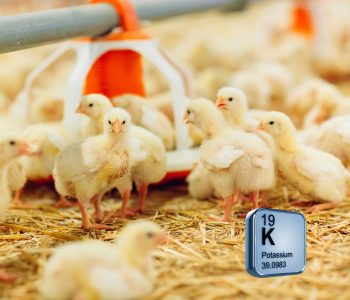Potassium is an essential nutrient needed by animals to maintain productivity and mitigate heat stress. It’s also a mobile nutrient, meaning it doesn’t leave reserves in the body and must be replenished in the daily ration. Without replenishment, animals can become deficient and experience reduced growth, muscle weakness or stiffening, reduced feed intake, nervous disorders, heart palpitations and more.
Finding the right balance comes down to your potassium source.
Electrolyte balancing, simplified
There are two common formulas for electrolyte balancing in animal nutrition, which help us understand potassium’s important role in rations.
The dietary electrolytic balance (dEB) formula is:
(Sodium + Potassium) – Chlorine
The dietary cation-anion difference (DCAD) formula is:
(Sodium + Potassium) – (Chlorine + Sulfur)
Both formulas are commonly manipulated to maximize animal health and productivity. Dietary levels of cations (sodium and potassium), which are positively charged ions, and anions (chlorine and sulfur), which are negatively charged ions, can be adjusted to create a balance that’s either positive or negative.
For example, in dairy cattle, pre-calving diets are designed for negative DCAD to prevent hypocalcemia, where lactating diets are designed for positive DCAD to support milk production.
What can cause an imbalance?
The relationship between these elements is closely linked. That means no single element can be looked at individually, as it takes a balance of all to maintain and optimize animal health.
The animal’s body has a buffering system to maintain near-normal physiologic pH and prevent most imbalances. However, many factors can impact element levels at any given time. For example, daily maintenance needs, production, and environmental factors like heat stress drain potassium, so extra dietary potassium is often required to maintain levels.
Do feedstuffs provide enough potassium?
What’s the best source of potassium in rations?
Potassium carbonate, found in Arm & Hammer DCAD Plus™, is the best choice for adding potassium into the ration.
Many nutritionists and farmers use potassium chloride; however, potassium chloride has a distinct drawback when it comes to electrolyte balance.
Potassium’s positive ionic charge and chloride’s negative ionic charge cancel each other out in the electrolytic balance. In other words, dEB or DCAD can’t become more positive to support production needs.
Potassium carbonate works differently because it only supplies potassium. It can be used to create a more positive dEB/DCAD, helping animals maintain production.
How does potassium heat feed?
Potassium sources typically generate heat when they are exposed to moisture. The heat generated ends up heating the entire ration, which can cause the feed to “cook” and lose essential nutrients. Protein is particularly susceptible.
Feed bins or silos can even generate steam when cooking occurs. A steaming feed pile should be spread out on the ground to allow feed to cool down. Fire is another risk.
Animals eating hot feed also feel the effects. Reducing ration heating is a necessary heat stress abatement strategy.
Choosing the right potassium source can help minimize ration heating risk, along with adding potassium to the ration near the end of feed mixing.
Which potassium sources minimize ration heating?
There are three primary sources for potassium in the diet:
- Potassium bicarbonate
- Anhydrous potassium carbonate
- Potassium carbonate sesquihydrate (DCAD Plus™)
Potassium bicarbonate doesn’t cause ration heating. But the bicarbonate form only contains half of the potassium compared to its carbonate counterpart. As a result, potassium bicarbonate costs about twice as much, making it impractical to use.
Anhydrous potassium carbonate generates a lot of heat when exposed to moisture, making ration heating a big concern.
DCAD Plus™ uses potassium carbonate sesquihydrate. This form of potassium does not generate heat because it has been partially hydrated – removing the potential for heating up in a moist ration.
Which species benefit most from potassium carbonate in the diet?
Many species can benefit from potassium carbonate in the diet. Most research has been done in lactating and non-lactating dairy cows, and nutritionists are comfortable managing DCAD levels in dairy rations.
While less widely adopted, poultry operations can apply the same principles to broiler and layer diet management with similar production and heat stress mitigation results.
Why should poultry producers use potassium carbonate?
Low potassium levels are dangerous for birds and can cause high blood pressure, heart disease and sudden death, especially in high-salt diets. Increasing potassium and reducing salt can help lower blood pressure and reduce risk of stroke.
Low potassium levels can also reduce calcium needed for strong bones and shells.
Additionally, electrolyte imbalance can cause metabolic issues like tibial dyschondroplasia and respiratory alkalosis in layers. Too much dietary sodium relative to potassium, paired with high chloride levels, can cause tibial dyschondroplasia. When chloride or sulfur levels are high, overall electrolyte balance is especially important – and cations (sodium and potassium) are needed to offset the negatively charged anions.
Birds are also susceptible to loss of potassium during times of heat stress, and sodium bicarbonate alone may not mitigate this stress.
When should you feed potassium carbonate?
Potassium carbonate can be added to the diet year-round and adjusted when needed to balance electrolytes and optimize production.
Where can I learn more?
Visit the Arm & Hammer website at ahfoodchain.com to learn more about potassium carbonate and DCAD Plus™, and find your local representative.
